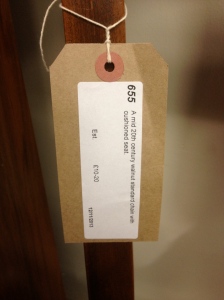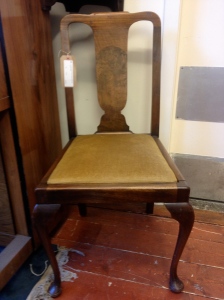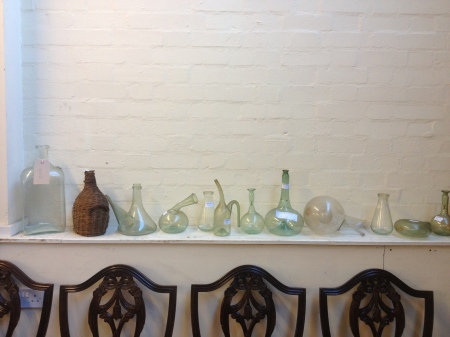Auctions are scary places, right? Full of expensive antiques, only for real traders who make a living out of it? It’s bound to be expensive, or you’ll wave a bit of card around by mistake and buy something you never intended to… oops.
In reality auction rooms are fascinating places and can be a great source of unusual items and inspiration as well as regular bargains. Any new buyer is good news for them so you will find them welcoming and happy to help.
The morning of the sale is usually very busy with a lot of people and this can be a bit overwhelming. If you can go along earlier in the week when it is calmer you can look around in peace. Auction houses will usually have a weekly pattern:
- Viewing days – usually 2-3 days before a sale and often including a weekend
- Sale day – with viewings in the morning but once the sale starts you can’t wander around and disturb everyone, you can arrive and leave anytime so don’t feel you have to stay for the whole thing
- Removal of sold items
- New stock coming in for the next sale
Catalogues
My local auction house has a catalogue hanging on a string (hi-tech stuff). You can buy one for £1 but sometimes it’s useful to just have a wander around first and see if there’s anything that catches your eye. You can refer to the catalogue to get an idea of the guide price but if there a few things you are interested in, it’s worth buying your own copy to have with you and make notes on. The other auction I go to uses labels on each item with the lot number and a brief description of the item with an estimated price. Catalogues are usually available online if you want to check, but often they don’t have photographs so they are never a replacement for looking in person.
Lot number
Each item has a lot number attached to it. Sometimes items are grouped together to make a large lot in which case they may be labelled 1 of 3. This can be a pain if you only want one side table and they have grouped three together, but you could always sell these on on or think of another use for them – maybe a friend would want one and you could halve your costs?
If you can’t find a lot number on an item, just go and ask.
Looking at the items
I do a quick walk around everything first to see what interests me. It’s always worth doing a slower second look – if you overlooked a piece the first time because it was tucked in a corner, or discounted it because it had a handle missing, the chances are other people may have done too and without so much competition you may get an even better bargain.
Once the hammer falls it’s a legal contract to buy at the agreed price. So make sure it’s right for you – check the measurements, open the drawers, is anything broken, if so can you mend it?
If there’s nothing you like that week, don’t discount the whole venue. The joy (and challenge) of auction rooms is that the stock changes weekly so just come back next time.
Working out your limit
The hammer price will have the sale room commission added to it. This varies from place to place but is around 15% and often has 20% VAT added to the commission. So if the hammer price is £100 you would pay 15% commission (£15) + £3 VAT on that making your total £118. Just make sure you’ve worked out the total cost – as the price rises the cost of purchase does too eg an £800 purchase would cost you an extra £144 on top (£120 commsiion + £24 VAT) A calculater can be useful in you want to be precise but I often just estimate 20% as I can work that out in my head.
Making a bid
There are 3 ways to make a bid:
- In person – which can be very exciting You will have to register at the desk and will usually have to bring ID. Sometimes they take card details as deposit in case you bid and then do a runner! You then get a bidder number to hold up as the sale goes ahead. You can also get carried away which is how I ended up with a framed set of South American butterflies..
- Leave a commission bid – Usually I am looking for furniture and at my auction house these lots usually start at about 4pm which is when I have to be collecting the children from school. Ask at the desk for a form and simply fill in the highest hammer price you would be prepared to pay (remember commission will be added to this). I was nervous this would mean that the auctioneer would always run the price up to my top price, but in my experience this has not proved to be true! The disadvantage is that you can lose out on winning for the sake of a small amount, it can also be difficult if there are more than one item you are interested in, but wouldn’t want to win both (eg two different tables)
- Telephone bidding – this is dealt with live during the course of the auction if you can’t be there in person. It is usually only for much higher value items.
The auction
The auction moves fast with approximately 100 lots being cleared every hour – if you want to be there in person you need some stamina and careful timing!
Collecting
You can only take items once the sale is finished and items have been processed so if your lot is in the middle of the sale be prepared to wait until the end or come back the following day to collect it. Most auction houses will charge a small storage fee if you don’t collect your lots within 24hours so be prepared. Some auction houses will also provide delivery for an extra cost but this is usually very swift as they need to get the goods moved out ready for the next sale so it can be an easy way of getting large items home.
If you didn’t win it
There will always be something similar again!
You can ask for information on what an item did sell for – then you know if your bid was in the right ball park for next time. I lost out on a chest of drawers, but only by £10 so I knew I was judging the sale level right, but I was just unlucky. The next week I had the winning bid on a Georgian mahogany chest of drawers. Yes, the wood is damaged on one of the feet and if I were looking for a resale on this it would no doubt cut the value. But it makes no difference to me – I’m happy with a beautiful Georgian chest of drawers that cost me just £180 which is a huge amount less than new solid wood drawers would be (and I didn’t have to assemble them!)





Great summary! Popped back to re-read it before heading out to an auction
Thanks Lauren, I hope you found something interesting. Remember, depending on the size of the auction rooms the lots can vary enormously from sale to sale. So if there was nothing that caught your eye this time, try another visit. Let me know how you got on.